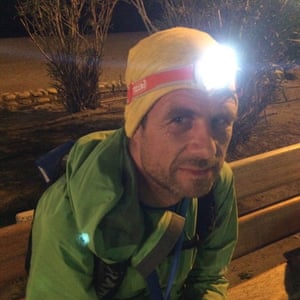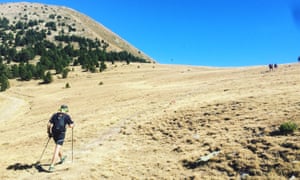Original link to article: https://www.theguardian.com/lifeandstyle/2017/nov/28/five-lessons-from-a-year-of-ultrarunning
All rights reserved by The Guardian.
Being an experienced runner, I was mistaken thinking that ultras would be more of the same. But making sure you prepare your head, body and your feet makes a world of difference

Before this year, I was a reasonably proficient marathon runner (PB: 2hr 50min), but I had never run an ultra – a foot race longer than a marathon. Intrigued by the ever-growing popularity of these races, I decided to ratchet up the distances. I ended up running six ultras in 2017, the last three of them in a mad five-week period, culminating with the epic 100 Miles Sud de France in the Pyrenees last month.
It has been a steep learning curve, and by the end of these races I knew things about how to survive and complete an ultra that I didn’t know before – things that might help others embarking on one in the future.
Of course, not everyone will agree, and there are many ways to approach an ultra, but just turning up with a pair of running shoes, some water and a few gels, as I did for the first one, and like you can in most shorter races, is not advisable. Ultras take planning. You need to be organised. That’s lesson one. [emphasis by LDM– Excellent! So for someone like me, a hyper-planner and one who thinks the longer and more complex the forms are, the better, at least I have this part down.] It’s a lesson I learned the hard way, and many are the times I’ve stood alone in a stew on the trail cursing my poor preparation.
Lesson one: get planning
One time was near the end of the second day of the Ring O’ Fire ultra I ran in Anglesey in September. The race is one complete lap of the Welsh island on the coastal path. I can just follow the signs, I thought. But when I got there, the other runners were all clutching well-marked maps. Others had phones with advanced trail finding apps downloaded. And all with good reason, because it turns out the coast path is not always easy to follow. [emphasis by LDM– Already encountering this in planning out the Quad Rock course map, wondering if the trail junctures will be marked clear enough to follow in training, wondering what might happen if I missed a turn, wondering if I could be quick enough to shadow other runners on training runs… but I love maps, so a detailed trusty map gives me hope]
The first day, a mere 35 miles, I got around by sticking like glue to other, more organised runners. But I realised this was not a foolproof system, so that first night I found a map and hastily drew the course for the remaining two days on it. I also installed the Viewranger app on my phone and downloaded the GPX file of the course, which had been on the race website all along.
But 62 miles into day two, as darkness was descending, I came to a crossroads. The sign for the coast path said turn left. My map said go straight on. I pulled out my phone. It was dead. Did I trust my map or the sign? I went for the sign as, in my haste I’d been far from careful plotting the route, I now realised. I’d just drawn it on my map roughly, thinking that would be close enough.
An hour later I was waving down cars, knocking on the doors of tiny cottages, scaring the life out of the local people, trying to find out where the hell I was. After more 12 hours running I was a mess. A mess of my own making.

Case study number two: coming out of Py in the Pyrenees, 11 hours into the 100 Miles Sud de France, as night fell, I pulled out my brand new Petzl MYO head torch. A top-of-the-range beauty straight out of the box. The light it gave off, though, was a bit dim. Maybe this was some clever lighting system that I hadn’t seen before. Dim light so you could see other things? No, that didn’t make sense. Then I realised – the batteries were dead. I couldn’t believe I hadn’t checked them before the start. I stood cursing myself once again. (Luckily the organisers insist you bring spare batteries and a spare head torch, so I did just about manage to make it through the night.)
Lesson two: take on enough sustenance
Every article on ultra running talks about this, and I’d read them all. I’d heard the quote countless times that an ultra is really just an eating competition with some running thrown in. But when you come from a road running background, it can be a hard message to fully take on board. [emphasis by LDM– Just looking at nutrition today, and marveling how on earth I could go from, say, 100 calories an hour, which is comfortable and good for me up to 5 hours/30 miles to the more recommended 200-300 calories per hour…]
So in the Miwok 100km race in California – my second ultra – I spent 20 miles struggling, weary, barely able to get myself beyond walking pace. Then at an aid station at 50 miles, some guy saw me trying to fill my pitiful thimble of a fold-up cup with a drink.
“That’s not a cup,” he said. “This is a cup.” He thrust a cup the size of a pint glass in front of me and filled it to the brim with an energy drink. I drank the whole thing down. Ten minutes later, I was running like a maniac, sprinting up hills, whooping as the other runners grimaced at this hyperactive imbecile in their midst.
I felt so good I ran right passed the next aid station without even stopping. Big mistake. Lesson still not learnt. Ten minutes later, I crashed again.

So, eat, drink, run, eat, drink, run. That’s an ultra.
Lesson three: get a bigger cup
For those races that make you bring your own cup, I now carry a huge, lightweight plastic vessel attached to the outside of my bag. And, at every aid station, I fill it to the brim.
Lesson four: get some extra cushioning
This may not be an issue for those with feet made of hardened leather, but for people with regular, soft, delicate feet like me, take note: you will need more cushioning for an ultra. This may be obvious, but I’m a steadfast believer in minimal running. I’ve spent a long time learning to run with good form and I long ago stopped heel striking. It means I can (usually) run in nice light racing flats. Even in marathons I cruise around wearing shoes specifically designed only for 5ks and 10ks. So I thought I could do the same in my ultras. I couldn’t.
In each race, I spent the last third or so with my feet on fire, trying to avoid any bit of hard ground, preferring whenever possible to run through long grass (slower) than on baked earth or tarmac (faster). This impacted on the rest of my body as I tried to change my form to protect my feet. I would finish each race in my minimal trail shoes glancing jealously at those people wearing those big fluffy Hokas. “It’s like running on a bouncy castle,” one Hoka runner told me. Eventually I caved in and got a pair.
And I have to say, they were a revelation. In the 100 Miles Sud de France, I was on my feet for almost 40 hours. That is a long time. My hip flexors ached, my quads were like bricks, by the end I was hallucinating … but my feet? My feet were fine.
Lesson five: turn off your GPS
This won’t be popular with everyone, and it has its drawbacks, but I found knowing that I still had 40 miles, or 50 miles, left, when I was already feeling dead on my feet, only stressed me out. Then, after what seemed like forever of running, I would look at the watch again and I’d have 39 or 49 miles left. It killed me each time, like running into a hedge. So in the 100 Miles Sud de France, I didn’t start my GPS. I just used the time, to get a rough idea of whether it was day or night. And mostly I felt more relaxed.
I asked many top ultra runners for their advice before I set out on this journey, and almost all said to try to stay in the moment, to take it one step at a time. This is sensible advice, crucial even, but almost impossible with a constant bleeping reminder on your arm of how far you still have to go. [emphasis by LDM– So here is a vote in favor of my tech-less running style — even music/ear buds are much too distracting for me, so while I might have to prepare more in lieu of GPS, I might be more ready to exist in the moment.]
Without it, I just kept moving, legs turning, up and down, through whatever the race threw at me until I got to the finish. Which, it turned out in France was more than 100 miles from the start, according to those who did keep their watches on. Seeing your watch click past 100 miles and to realise the end is still nowhere in sight must be incredibly debilitating. But me, I ran on in blissful ignorance, churning away, like a monk mediating on the moment. Well, sort of.
So, now I’m an expert, which is lucky because I’m hoping to run the most competitive ultra in the world next year, the Ultra-Trail du Mont Blanc. I’ll need every advantage I can get to finish that in one piece, so if you have any tips of your own, please share them below.


